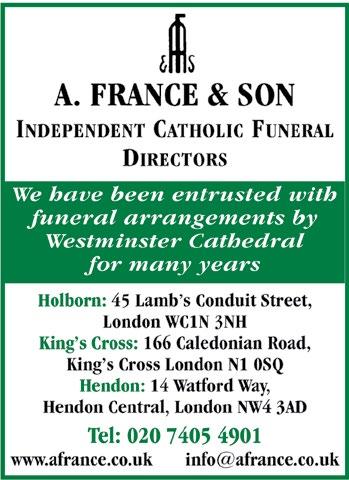Westminster Cathedral Magazine

Cardinal Vincent pauses before blessing the ashes for imposition at Mass to mark the beginning of Lent
If you can, please make a donation for your copy to cover its production cost.
Thank you.


Cardinal Vincent pauses before blessing the ashes for imposition at Mass to mark the beginning of Lent
If you can, please make a donation for your copy to cover its production cost.
Thank you.
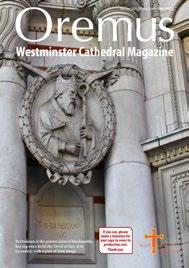
Although we earn income from the advertising which we carry, Oremus relies on donations from readers to cover its production costs.
The Companions of Oremus was established to recognise those who give generously to support us. Open exclusively to individuals, Companions’ names are published in the magazine each month (see page 7). All members are invited to one or more social events during the year and Mass is offered for their intentions from time to time.
If you would like to support us by joining the Companions, please write to Oremus, Cathedral Clergy House, 42 Francis Street, London SW1P 1QW or email oremuscomps@rcdow.org.uk with your contact details, including postcode. Members are asked to give a minimum of £100 annually. Please mention how you would like your name to appear in our membership list and if you are eligible to Gift Aid your donation. Postal subscriptions to Oremus may be purchased by completing and sending to the office the coupon printed in the magazine. Subscriptions to receive Oremus either by email (free) or as hard copy by post (p & p payable) can also be entered by visiting https://westminstercathedral.org.uk/the-cathedral-community/about-oremus/ and completing the form there.
Thank you for your support.

Cathedral Clergy House
42 Francis Street
London SW1P 1QW
T 020 7798 9055

E oremus@westminstercathedral.org.uk
W www.westminstercathedral.org.uk
Oremus, the magazine of Westminster Cathedral, re ects the life of the Cathedral and the lives of those who make it a place of faith in central London. If you think that you would like to contribute an article or an item of news, please contact the Editor.
Patron
e Cardinal Archbishop of Westminster
Chairman
Fr Sławomir Witon´
Editor
Fr John Scott
Oremus Team
Tony Banks – Distribution
Marie Carne – Content Compilation
Ellen Gomes – Archives
Zoe Goodway – Marketing & Finance
Paul Moynihan – Proofreading
Manel Silva – Subscriptions
Design and Art Direction
Julian Game
Registered Charity Number 233699 ISSN 1366-7203
Opinions expressed by contributors do not necessarily represent the views of the Editor or the Oremus Team. Neither are they the o cial views of Westminster Cathedral. e Editor reserves the right to edit all contributions. Publication of advertisements does not imply any form of recommendation or endorsement. Unless otherwise stated, photographs are published under a creative commons or similar licence. Every e ort is made to credit all images. No part of this publication may be reproduced without permission.

On Ash Wednesday Cardinal Vincent chose to celebrate the rst Cathedral Mass of the day. is year the whole of March is taken over by Lent, ending with the Triduum and the Lord’s Resurrection on the 31st.
Cathedral Life, Past & Present
J S Bach’s St John Passion –A
Gaza and the West Bank –e Cardinal’s Call to Prayer
Canons of the Cathedral Chapter –Canon John O’Leary 12 & 13
Cathedral History – Early Mosaicists by Patrick Rogers 14 & 15
Memoirs of a Cathedral Chorister 1916 - 1921 by Philip Hodges (continued) 16 & 17
Cathedral History, A Pictorial Record –St Patrick’s Day 1932 by Paul Tobin
e Baptistry – An Artists’ Reception by Edward
Features
An Exhibition in Retrospect – St Francis by Christopher Howse 6 & 7
Notre Dame de Paris at Westminster Abbey 8
‘Scrap the Cap’ for Catholic Free Schools by the Catholic Union 8
Notre Dame du Dimanche An Anniversary by David Fenton 9
Legion: Life in the Roman Army at the British Museum by Lucien de Guise 10 & 11
Regulars From the Editor 5 Monthly Album 18 & 19 Poems and Crossword 22 In Retrospect –from the Westminster Cathedral Chronicle 23
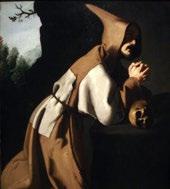
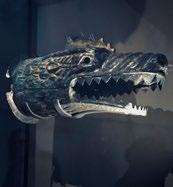

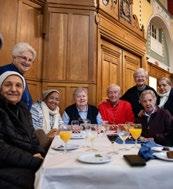

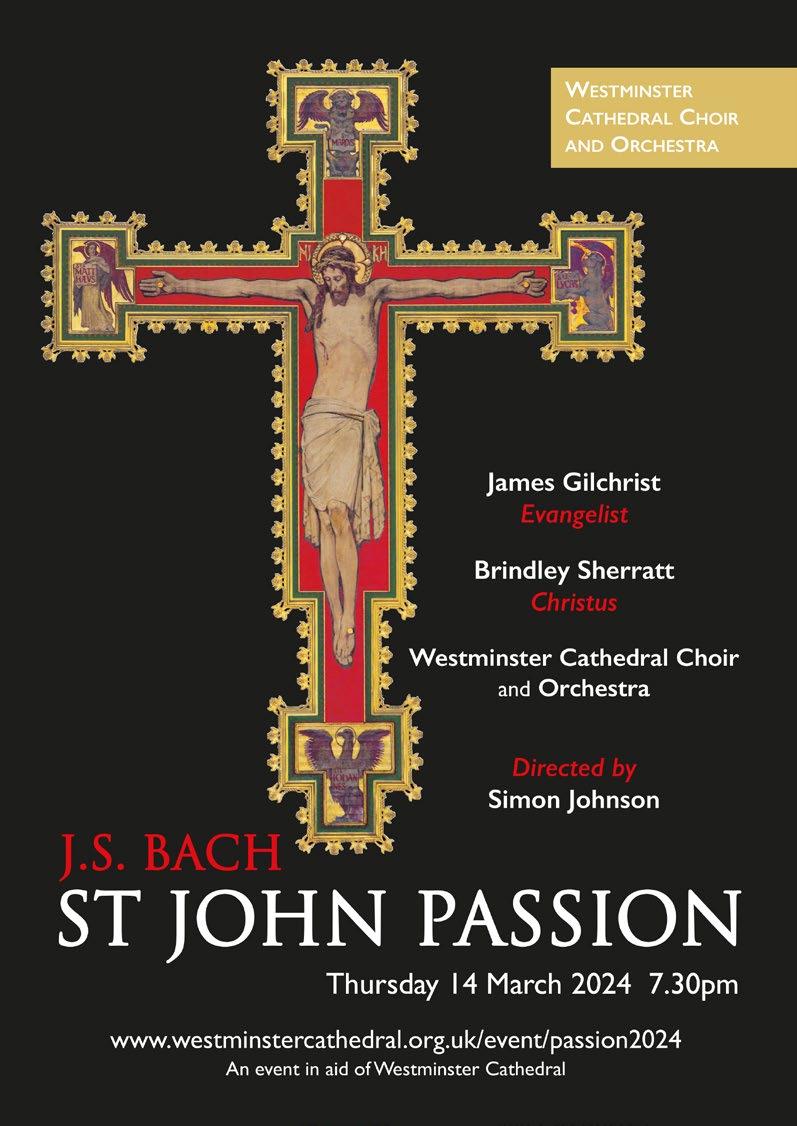

I had already started researching a cover image for this edition before I realised that the relatively early date of Easter, with its Octave, means that Our Lady will not have her day until the second week of April. Therefore, the cover image, taken from the Cardinal’s Ash Wednesday Mass, can remind us of our Lenten discipline and hope, to be fulfilled on the very last day of this month in the Lord’s Resurrection. As the New Year is the time for resolutions, so is Lent the time for deeds.
Oremus continues the publication of Philip Hodges’ early 20th century Chorister Memoir and it is gratifying to have heard from members of his family how pleased they are to see it in print. Indeed, a parcel of music written by Philip in later years has recently arrived here and I have passed it to the Music Department for their archive.
Thinking of younger people, you may be surprised to note, as I was, that the School of Mosaicists once based in the Cathedral Tower included apprentices drawn from ‘Canon Craven’s Crusade of Rescue’ -willing or unwilling volunteers one wonders? I am not aware that any of the present Cathedral Canons have such institutions attached to their names, but, resuming this month a series on the lives and ministeries of the Canons, we discover how Canon John O’Leary finds himself in the responsible role of Rector of Allen Hall Seminary, supervising the formation of our future priests.
Then, two contrasting stories from the Church in France. For a few months down the road at Westminster Abbey there is an exhibition on the history and rebuilding of Notre Dame Cathedral in Paris, doubtless timed and internationally publicised in advance of the Cathedral’s reopening at the end of this year, when the Gloire of La Belle France will be on full show. Contrastingly, I report on last summer’s 150th anniversary celebrations at the rural shrine of Notre Dame du Dimanche (she does not approve of working on Sundays). Curiously Our Lady’s apparitions there are judged to be as credible as those at Lourdes. Perhaps the message is that God desires to make himself known to rich and poor, high and low, in every place.
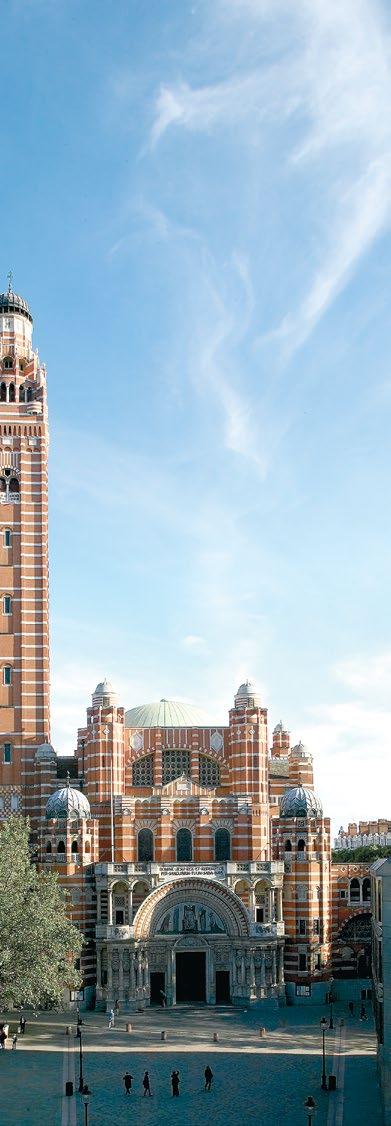
Westminster Cathedral
Cathedral Clergy House
42 Francis Street
London SW1P 1QW
Telephone 020 7798 9055
Email chreception@rcdow.org.uk
www.westminstercathedral.org.uk
Cathedral Chaplains
Fr Sławomir Witon´ ,Dean
Fr Brian O’Mahony, Sub-Dean
Fr Hugh MacKenzie
Fr Mike Maguire, Precentor
Fr Vincent Mbu’i SVD
Fr John Scott, Registrar
Also in residence
Franciscan Sisters of Our Lady of Victories: Sr Angelina, Sr Fatima and Sr Jesuina
Music Department
Simon Johnson,MasterofMusic
Peter Stevens Obl. OSB, AssistantMasterofMusic
Chris Too, OrganScholar
Cathedral Manager
Peter McNulty
Estates Manager
Neil Fairbairn
Finance Manager
Algernon Keuneman
Fundraising Manager
Laura Dudhee (Maternity cover)
Chapel of Ease
Sacred Heart Church
Horseferry Road SW1P 2EF
Christopher Howse
An exhibition at the National Gallery in London in 2023 called St Francis of Assisi was widely enjoyed and praised. Sometimes British people absorb religious truths by admiring art. at was what happened in 2009 with the exhibition called e Sacred Made Real, also at the National Gallery. It made forceful use of Spanish polychrome statuary of the 17th century.
Some of it shocked a British audience: the realistic sculpture of Christ dead in the tomb, covered with wounds and blood, by Gregorio Fernández, or the halflength Man of Sorrows showing Christ a er his scourging, by Pedro de Mena. But it was obvious a er that exhibition that polychrome statuary could not be dismissed as bad taste or t only for dark side chapels of foreign churches. Of course, even though thousands saw that exhibition, they remained a small minority of the nation. But the default attitude had changed: the religion that this art re ected had to be taken seriously. at exhibition in 2009 included a statue of St Francis of Assisi standing in meditation, by Pedro de Mena, and it also showed the extraordinary painting, 5 high, of St Francis kneeling in meditation, by Francisco de Zurbarán. It is on permanent display in the National Gallery, but perhaps o en gets overlooked for that reason. is painting was the star exhibit (apart from one which I shall mention later) at the St Francis of Assisi exhibition 14 years later. It was worth seeing in reality, because no reproduction of it can do justice, for example, to the shaded face just discernible within the deep frame of the cowl. Zurbarán is celebrated for his representation of textiles, and here the patched habit of the poverello, the man of poverty, is depicted in a setting without details, promoting a sense of tranquillity and detachment from the world.
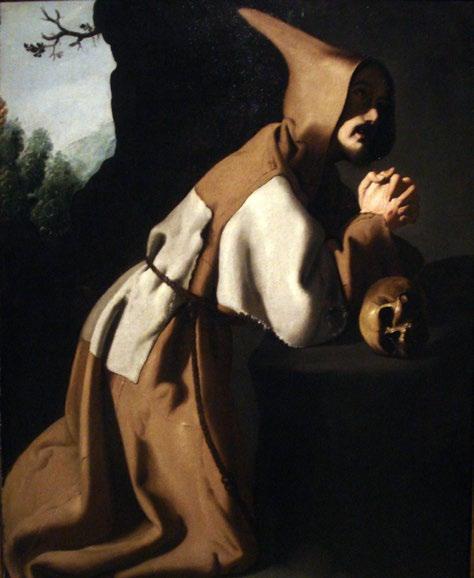
e people who came to see the St Francis exhibition were probably well disposed to the saint, or what they knew of him. To them he valued the natural world. e exhibition catalogue opened with the Canticle of the Sun, in the Umbrian dialect and in English translation: ‘Praised be You, my Lord, through all Your creatures, / Especially Sir Brother Sun, who is the day; and through whom You give us light. / And he is beautiful and radiant with great splendour / And bears a likeness of You, Most High One’.
But if they got to the end of the short Canticle, they would have found less easy thoughts: ‘Praised be You, my Lord, through our Sister Bodily Death, / From whom no one living can escape. / Woe to those who die in mortal sin’.
An essay in the exhibition catalogue by André Vauchez quoted G K Chesterton’s criticism of 19th-century biographers
like Ernest Renan or Matthew Arnold who discounted Francis’ asceticism: ‘ e moment Francis began to do something they did not understand or did not like, they did not try to understand, still less to like it; they simply turned their backs’.
Something like this explains the antipathy of one 19th-century critic, who called this stupendous Zurbarán, when the National Gallery bought it for £265 in 1853 ‘a small, black, repulsive picture’. It certainly couldn’t be called small, and the critic in question, William Coningham, was no philistine. Indeed, in 1848 he had given the gallery two large panels from a Florentine altarpiece showing adoring saints, in which St Francis stands beside St Stephen the rst martyr.
St Francis is the saint (apart from those in the Bible) who is the most widely represented in art, yet aspects of his life and message repel the dominant sensibility
of one period or another. In our day many discount St Francis’ commitment to religious doctrine. e exhibition featured a big woodcut diptych by Andrea Büttner of St Francis preaching to the birds. is, we learnt from the caption, was a remaking of one of the 20 scenes from the saint’s life depicted in 1250 on the walls of Santa Croce, Florence. In both pictures, the birds sit attentively in rows.
What we miss by Andrea Büttner’s selection of the scene of preaching to the birds is that in Florence the scene immediately below is of St Francis preaching to the Muslims, in the court of the Sultan of Egypt. Historically it was a visit that St Francis certainly made, in 1219 – with more risk than ru ing a few feathers. e exhibition as a whole did not ignore this important incident
Lally Ambatali
Mrs Mary Barsh in memoriam
Dr Stuart Blackie
Anne Veronica Bond
Lolita Botanes
Richard Bremer
Lorenzo Cabrelli
Ms Virginia Pinto Cassama
Mrs Erlinda Chin
Francis George Clark
R & L Collyer-Hamlin
Daniel Crowley
Angelita Caronan Duran
Ms Georgina Enang
Fr Joseph Farrell K.H.S. Golden Jubilee
Wendy Felstead
Alfredo Fernandez
Fred Gardiner
William Gardner-Hunter
Connie Gibbes
Zoe & Nick Goodway
Rosalinda Grimaldo
Agnes Haein KIM
Mrs Valerie Hamblen
Bernadette Hau
Mrs Cliona Howell
Carl Stephen Patrick Hunter OBE
Alice M Jones & Jacob F Jones
Poppy K
Rosanne Kay
Mary Thérèse Kelly
John Langan
David Lawton
Raymund Livesey
in the life of St Francis; two paintings, by Sassetta and Fra Angelico, showed him before the Sultan. For St Francis it was important to bring the Gospel to the whole world, so that everyone might believe in it. In January 1220, only months a er his meeting with the Sultan, ve of his Francican friars were put to death in Marrakesh. ey were formally declared saints in the 15th century.
St Francis himself would certainly not have minded if his own approach to the Sultan had been rewarded with martyrdom. It was not that he courted death, but that he sought to be a witness ('martyr') to Christ.
His own witness was expressed by faithfulness to his rule of life. is is where the object I found most moving in the
National Gallery’s exhibition comes in: it was the sackcloth habit reputed to have been worn by the saint. e coarse-spun garment was housed in a gilt Baroque frame, not because it was 'art' but because it is a relic, to be viewed with devotion.
None of the older paintings in the exhibition – an El Greco with palpable clouds resolving into a vision of Christ, or a great big Murillo of the saint embracing Christ on the Cross – were made to be seen in a museum. ey were optical instruments of religion, windows to another world. I think that, although the National Gallery remained a museum, some of the visitors were able to look through that window.
Christopher Howse is an assistant editor of e Daily Telegraph.
We are very grateful for the support of
Alan Lloyd in memoriam
Clare and John Lusby
Pamela McGrath
Linda McHugh
Christiana Thérèse Macarthy-Woods
Ms Ludivina Mangmang
James Maple
Paul Marsden
Mary Maxwell
Abundia Toledo Munar
Euphrasie Mundele Kilolo
Chris Stewart Munro
Mrs Brigid Murphy
Kate Nealon
Cordelia Onodu
Cris Ragonton
Alan Rainer
Emel Rochat
Berenice Roetheli in memoriam
Clementina Rokosu
Precy Salvador
John Scanlan
Sonja Soper
Tessa and Ben Strickland
Yollie Sumayod
Julia Sutherland
Eileen Terry
Robin Michael Tinsley
Lucila Torre el
Mr Alex Walker
Peter W Wilson
and of our anonymous Companions
If you would like to become a Companion of Oremus, see page 2
The immersive exhibition Notre Dame de Paris, has opened at Westminster Abbey and runs until 1st June.
Revealing the story of the French gothic masterpiece, from its origins in the 12th century and its 850-year history to its painstaking restoration following the devastating fire of 2019, the exhibition has been created by digital heritage specialists, Histovery, in collaboration with Rebuilding Notre-Dame de Paris and supported by L'Oréal Groupe.
Already seen by 300,000 exhibitiongoers worldwide including in Paris, Washington, Montreal and Dubai, the UK location is the 13th century Chapter House at Westminster Abbey, another masterpiece of Gothic architecture. The exhibition takes visitors on an interactive journey through Notre Dame's past, including the lavish wedding of King Henri IV, the glittering coronation of Napoleon Bonaparte, and the 19th century construction of Notre-Dame's iconic spire designed by Viollet-le-Duc, which was tragically destroyed by the fire. The skill, artistry and vision over the ages of its architects, craftsmen and builders, and the 21st century experts who are bringing it back to its former glory will be brought to life in the show.
Visitors to the exhibition are issued a 'HistoPad' (tm) a portable, touchscreen tablet developed by Histovery that will serve as their portal to key moments in Notre-Dame's history and restoration. The intuitive device's technology is accessible to visitors of all ages and levels of technological ability. The tour is available in 13 languages and there are special features for families: a virtual treasure hunt to collect stained glass window fragments to win a diploma, and a fun selfie studio which superimposes faces onto the cathedral's fantastical beasts.
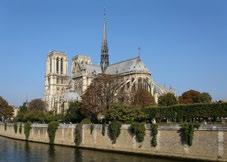
The Histopad tour through NotreDame's history is designed to envelop the visitor in a multi-sensory experience - including audio of the cathedral's organ and tolling bells, a full-size replica of one of the structure's famed chimera statues, and a projection of one of Notre-Dame's iconic rose windows, which survived the fire.
Notre Dame is due to reopen again after restoration work on 8th December this year.
The Very Reverend Dr David Hoyle, Dean of Westminster Abbey, said: ‘Like many around the world we were deeply shocked by the fire at Notre Dame de Paris. Since then, we have watched with admiration as the cathedral is painstakingly restored to its former glory, and we are looking forward with great anticipation to its re-opening later this year. Today we celebrate the opening of this immersive exhibition about Notre Dame de Paris which merges the medieval with the modern in a magnificent way’.
Booking:
Find out more about the exhibition and how you can book your tickets https:// www.westminster-abbey.org/abbeyevents
Watch:
Notre Dame de Paris exhibition trailer: www.youtube.com/ watch?v=ME2pCcYmuR4

e Catholic Union was back in No 10 Downing Street recently to talk about the future of Catholic schools.
Deputy Director, James SomervilleMeikle, together with Paul Barber, Director of the Catholic Education Service, met the Prime Minister's education adviser to discuss the faithbased admissions cap on new free schools.
Last year, the Catholic Union launched a new campaign to 'Scrap the Cap' and allow Catholic free schools to open. Over 1,000 people signed an open letter to the Education Secretary, Gillian Keegan, asking her nally to li the cap. e meeting in No 10 is the latest stage in the campaign and builds on previous meetings with o cials and Special Advisers and a meeting with the Education Secretary at the end of last year. James and Paul highlighted the bene ts of li ing the cap, which would allow the Catholic Church to take part in the Free School Programme which was launched in 2010. Li ing the cap would not just allow new schools to be built, but permit existing schools to convert to academies.
ey stressed that Catholic schools are already some of the most diverse in the country, with nearly half of pupils from an ethnic minority background.
e campaign continues, building on the Church’s commitment to education in the diocese dating back to the pioneering work and commitment of Cardinal Manning.
Links: Catholic Union: https://catholicunion.org.uk/ Catholic Union launches campaign to Scrap the Cap: www.indcatholicnews. com/news/47474
David Fenton
In an article of January 2019 in Oremus, David described the 19th century appearances of Our Lady in the predominantly rural vinegrowing area of France’s Languedoc which led to the establishment of the shrine of Notre Dame du Dimanche. Although little known, devotion at the shrine has continued, culminating in last summer’s celebration of its 150th anniversary.
e joyful celebrations took place at Saint Bauzille de la Sylve in the diocese of Montpellier. e apparitions were described by the Midi Libre as ‘un evenement considerable de l’histoire heraultais’ and by the Diocesan commission as comparable to Lourdes. It was tting, therefore, that Mgr Nicolas Brouwet, former Bishop of Tarbes et Lourdes and now Bishop of Nîmes, presided over the rst anniversary on 8 June.
The Bishop seemed very moved and spoke from the heart in the beautiful setting of the shrine, so close to nature, surrounded by numerous vines and the work of human hands.
The serene setting formed a considerable contrast to the grandeur of the shrine at Lourdes, including the 400 or so pilgrims who attended. The day started with Mass and Angelus, followed by a reception and picnic lunch. There were also food trucks offering favourite treats, including ‘fish and chips’! In the afternoon there was a conference and the day finished with a candlelight procession at dusk. Bernard Daudé, a prime mover with the shrine’s Friends, and other great-grandchildren of Auguste Arnaud, the original visionary, were in attendance. The work of the Friends had ensured that the shrine was in pristine condition, with the Chapel, wrought iron and gold on the statue of the Virgin of the Apparitions all freshly painted.
Celebration of the second and third apparitions followed a month later, presided over by Mgr Norbert Torini, Archbishop of Montpellier. In thirty-three degree heat, the faithful, numbering about nine hundred, were accompanied by a chorus of cicadas. The day followed a familiar pattern, with the addition of a late afternoon procession of the Blessed Sacrament for the sick who had come from Montpellier and the surrounding region.
The Shrine has its own canticle, celebrating Mary’s appearance to Auguste as he tended his vines, incorporating her instruction to observe Sunday with prayer:
Vierge du Dimanche, Bénis tes enfants
Daigne Vierge blanche, écouter leurs chants
Travaillant sa vigne, un homme au coeur bon
Eut l’honneur insigne, d’une apparition
C’était un dimanche, tandis qu’il bêchait
Une vierge blanche soudain apparaît
La dame se penche et dit au voyant
“Mon fils le Dimanche, s’observe en priant”
“Dans un mois de même, reviens travailler
Je viendrai moi-même te remercier”
Cardinal Vincent has written to priests in the diocese to ask for a special focus of prayer on 8 March for peace in the Holy Land. In his message, he writes: 'As we are all aware, the situation in the Holy Land has not improved, with failed negotiations, increasing humanitarian distress and a rising death toll. As Lent begins, I would like to urge that we continue our efforts, not least in prayer. And so I ask that, on Friday 8 March, there is a special focus of prayer for the Holy Land across the diocese. This could take the form of a dedicated time of prayer, perhaps before the Blessed Sacrament, for peace in the Holy Land. It could
be as simple as making any regular Lenten devotions you may be having on that day for this intention.
He asks priests to make their 'parishioners aware, and encourage them to make a special effort to take part in these prayers and devotions in their parishes’. In the Cathedral on 8 March Mass and Confession times will be as usual, but there will be afternoon Exposition of the Blessed Sacrament on the High Altar as a focus for our prayers and all are encouraged to take part in the evening’s Stations of the Cross, offering them as part of our prayer intention for peace.
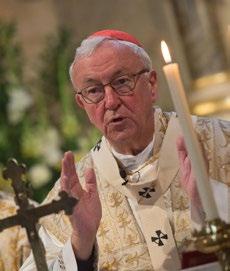
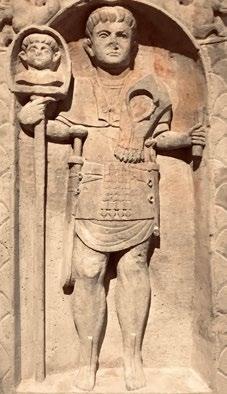
e British Museum has started the year with an exhibition that should meet with the approval of culturalrepatriation enthusiasts. ere are no pilfered treasures from Greece, Ghana, Benin, Ethiopia or Easter Island. Instead, it is bringing on Colchester (Essex) and Fenstanton (Cambridgeshire). ere is a lot more than the British periphery of the Roman Empire on display. Legion: life in the Roman army is about the military throughout the empire. Britannia was just a remote outpost, but by no means the worst posting for a soldier. e natives were not complete savages, like Germany, and the local women could be in some demand. e warriors were described as ‘wretched little Britons’. You don’t see much of them, the glory of Rome was de ned by immortalising
its own people. Whether in stone or papyrus or their exquisite coins, they have le a massive stash of information about their lives and aspirations.
e exhibition follows the progress of Claudius Terentianus, a recruit from Egypt. He was a real Roman soldier, well known to historians through the papyrus letters he sent to his father. His career is mirrored by an extra who has received little approbation from other reviewers. Claudius Terrattus is a cartoon rat from the Horrible Histories menagerie, and he brings as much cuteness to his role as a rat can manage. When I visited, almost nobody was paying any attention to the jaunty illustrations and descriptions that have been provided throughout the show. ere were few visitors under 50, so perhaps they couldn’t be bothered with such juvenilia (a typical pun from Terrattus would be ‘rat-tirement for me!‘) As these were the only quiet spaces in the enormous Sainsbury Gallery, it’s possible to savour the dumbed-down erudition, which is tailored to a young audience, rather than the information naimed at grown-ups. e British Museum has been sliding into the worrying habit of underestimating its visitors’ intelligence. Instead of stating ‘ rst and second centuries’ it’s now ‘100s to200s‘.


e captions and information panels are important for an exhibition that is more about learning than aesthetics. e Romans have always been considered practical people, unlike those thinkers and dreamers on the other side of the Adriatic. Few of the exhibits are dropdead stunning. ey are more likely to be tombstones: informative rather than inspirational. e folksiness of some stone carvings can be more enjoyable than the supposed high art of the Hellenes that we hear so much about.
With the Parthenon Marbles nearby, a frieze of warlike Roman horsemen should have its work cut out trying to make an impression. In terms of animation and exuberance, the Romans had as much skill as the Athenians. Perhaps there is more vitality to this item because it’s a single stone, equipped with more dramatic lighting than the Duveen Gallery with its endlessly contested and coolly displayed friezes procured by Lord Elgin. I’ve always preferred the pared-down spontaneity of tribal art – or primitive art as it was once called – although it’s unlikely that the Romans would appreciate this compliment.
e eld in which the Romans tried hardest to compete with the Greeks was portraits of their emperors. ese tend to have the sophistication that seekers of sleek antiquity long for. Hadrian looks thoughtfully serene, Galba seems grimly determined, while Commodus looks con dent in his imaginary god-like status ese are the traditional, ‘artistic’ elements of the exhibition. Most of the show is about the business of soldiering. is entails the ancient equivalent of what one used to nd in army-surplus stores when they existed. Tents, for example, were a vital bit of kit then as they are now. e di erence is that Roman soldiers had to pay for their own. It was the same with their uniforms, which could be very expensive indeed. I once read that the subaltern Winston Churchill’s rst dress uniform cost him a year’s pay. e other ranks didn’t have to stump up in the British Army, while their Roman counterparts did. e other di erence is that few Roman out ts have survived, and they tend to be understandably decrepit. ese include helmets and cuirasses and remarkable crocodile-skin protective armour. All are fascinating for the stories they tell. ey are not resplendent with colour or shimmering precious metals. For more vibrant hues, an ancient shield veritably sets the gallery on re with a palette that has dulled a bit over the years but still provides a more useful indication of what battle might have been like. Perhaps we all visualise history in colour rather than monochrome, in which case young visitors get a better deal. ey can not only li a dazzlingly painted shield to test the weight, they can also try on a legionary’s helmet. All in front of a massive mirror, ideal for the age of the sel e. e drabbest and most depressing item is an armoured blanket for a horse. It brings home the grim nature of warfare, an art at which the Romans excelled. ey were constantly on campaign in di erent parts of their empire, including Britain. When they weren’t waging war they were simulating it at the circus. Gladiators have to get a mention, and what better example than an actual emperor? Commodus seems to have gone insane and fancied himself as a ghter and Conqueror of the World as well as a god. It seems he wasn’t that good but he survived.
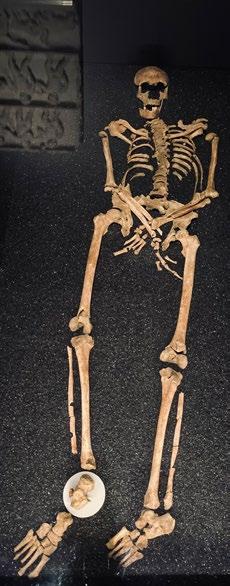
There appears to be no mention of Christians being fed to the lions, or doing very much at all. The biggest gap in an otherwise comprehensive exhibition is the sect that came out of the East and eventually made Rome its headquarters. Christians deserve more of a mention, as does Christ. For me, the most remarkable exhibit of all is an exceedingly rare skeleton. It has an obvious indication of having been crucified: a large iron nail through the ankle. Truly astonishing is that it was found in Cambridgeshire. There is very little evidence for the remains of the 6,000 or so slaves from Spartacus’ rebellion in 71 BC, and yet a crucified man was found as recently as 2017 in East Anglia. How many such executions can there have been in Britannia?
It’s a poignant moment to see the evidence of this Roman barbarism. Explaining the importance of judicial killing, they omit the most famous victim of all. Of course Our Lord never served in any army, but if they are not going to mention his cruci xion, could they not have mentioned his contact with Roman soldiers? In the British Museum’s admirable attempt to bring the Roman military closer to modern observers, they have missed out on the enduring links. In addition to Longinus, who was a vital participant in the Cruci xion, there was the Roman centurion who gave us the timeless words recorded by St Matthew: ‘Lord, I am not worthy that you should come under my roof: but speak the word only, and my servant shall be healed’.
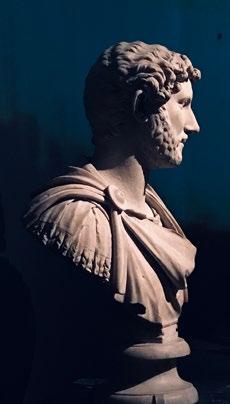
Hadrian was among the kinder emperors to Christians, not that this is mentioned in
ere is also St Alban, a Roman citizen as well as being the rst Christian martyr in Britain. His name lives on while Verulamium does not. Westminster Cathedral is proud to commemorate him with a mosaic. e ancient Roman gods are hardly celebrated anywhere, although there is no doubt some branch of the Wicca that aims to change that.
Legion: life in the Roman army at the British Museum, ends 23 June.
‘The Centre of the Universe’: my description of The Most Sacred Heart, Ruislip; the vibrant parish where I grew up after my birth in 1967. My father was Irish, my mother is English. After redundancy from factory work, Dad became a porter at Harefield Hospital. Mum, a convert, nursed at Mount Vernon. Dad is deceased, while Mum still lives in Ruislip. I am the youngest of six. Sadly, two siblings have died: Francis, my only brother, of leukaemia, aged 26 (soon after my diaconate ordination) and Maria, at 47, from a heart attack. My home parish’s life of faith, rooted in and sustained by the Lord’s presence in the Mass, enabled me to listen and respond to the Father’s call to ministerial priesthood. Serving at a number of ordinations in the parish was an immense inspiration. Likewise, the example of two superb parish priests, Fathers Peter Geraerts and (later Mgr Canon) Adrian Arrowsmith (Fr. A). Both proclaimed the Gospel with the clarity arising from shepherds’ hearts.
Fr A. took me on the parish pilgrimage to Rome. It was a signi cant turning point. Priesthood had entered my mind; but I was intent on an army career. Celibacy did not attract. Being a pilgrim taught me not to fear Jesus’ invitation: ‘Follow me’. Fr Michael Johnson, then Vocations’ Director, later PP of Ruislip, let me apply while still in sixth form to begin seminary formation a er A-Levels. Wisely he also advised me to apply to universities. I received o ers to study geography. However, Cardinal Hume accepted me for formation on leaving school. us, in 1985 I started at Allen Hall. Fellow Ruislip parishioner, Duncan Adamson started seminary too, at the Beda College. As parish MC and friend, Duncan helped me to welcome what Jesus desires for us. His nal appointment before dying in 2022 was Parish Priest of Ruislip.
A er two years at Allen Hall, I moved to the Venerable English College (VEC), Rome. Defeating the Scots College at football remains a pleasurable memory! Even better, deaconing at a Mass celebrated by Pope St John Paul II. My ve years at the VEC were not all plain sailing. Challenges and doubts arose. Yet I am full of gratitude for these. By God’s grace, often channelled through brother seminarians, they fostered maturity. e witness of Canon John McDonald, by now PP of Sacred Heart, encouraged me through to 18 July, 1992: what a great joy to be ordained priest by Cardinal Hume in the church where I was baptised, received rst Holy Communion and con rmed! e parish continues to nurture that gi of priesthood received over 30 years ago.
Over those years, appointments have been many and varied. None always easy; all rewarding. I have served as assistant priest in Brook Green and Tottenham, then parish
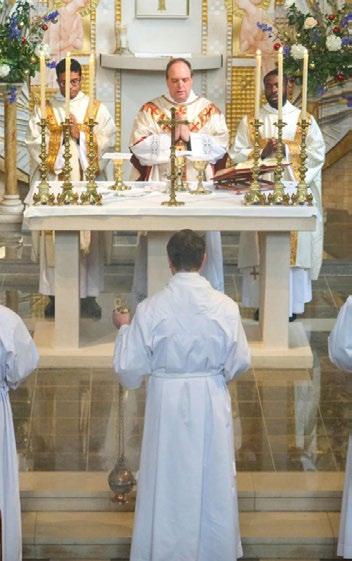
priest of Shepherds Bush, Kingsland and Tollington Park. In all these places, the Holy Spirit, inflaming countless people’s charity, deepened my trust in Jesus and his, our Father. Tollington Park was combined with being Vocations Director. Many of the men I accompanied are now, praise God, priests. For three joyful years I was assistant chaplain to the universities of London, based at Newman House. Witnessing students’ weddings worldwide has been lovely. Whilst at Newman House, and then Shepherd’s Bush, I also taught philosophy at Allen Hall. In 1995, Cardinal Cormac permitted me to pursue doctoral studies at Heythrop College, based at Lincoln’s Inn Parish. Parishioners kept me going (as did theatre trips) when my thesis on materialist neuroscientists and the immortal soul encountered dead-ends.

Archbishop (now Cardinal) Vincent Nichols appointed me his Private Secretary in 2011. A kaleidoscope of experiences followed. Visiting so many parishes and schools was wonderful. Journeys to Erbil in Iraqi Kurdistan and Gaza are engraved deeply in my heart, as is meeting Popes Benedict XVI and Francis. Whilst Private Secretary I became chaplain to the Catholic Medical Association and member of St John and St Elizabeth Hospital Ethics Committee.
2019 marked my return to Allen Hall, as Vice-Rector and Dean of Studies. The partnership between Allen Hall, Mater Ecclesia College and St Mary’s University was just underway. It enables seminarians to obtain pontifical and civil degrees. I resumed teaching philosophy, and began teaching theology at St Mary’s. This continues in my current post as Rector. What’s it like being Rector? A privilege! Humbling too! I am certainly not the best priest for this ministry. Thankfully, then, conforming seminarians to Christ the High Priest, moulding earthenware jars to hold divine treasure, really is the Holy Trinity’s achievement. Thus, as did our Douai Martyrs: vivamus in spe (let us live in hope – Allen Hall’s motto).
Installation as a Canon and election as Canon Theologian coincided with my silver jubilee year. As a Chapter member, I endeavour to support the Cathedral’s mission particularly by prayer and hearing confessions when possible. Most importantly, I offer Mass for the diocese, that the Most Sacred Heart, beating in the Eucharist, may be for us all the centre of our universe.

Patrick Rogers
By the end of the 1914-18 War four of the Cathedral chapels had been decorated with marble and mosaic – e Holy Souls, St Gregory and St Augustine’s, St Andrew’s, and the Shrine of the Sacred Heart. In addition the main entrance tympanum, the Lady Chapel altarpiece and a few panels elsewhere had also been completed. Seven di erent artists, including J F Bentley, the Cathedral architect, had been responsible for a wide variety of mosaic designs but, with the possible exception of St Andrew’s Chapel, Cardinal Bourne was satis ed with none of them.
As mentioned earlier, in November 1905, two years a er his installation as Fourth Archbishop of Westminster, Bourne was in Rome and from there travelled to Sicily speci cally to see the 12th century Byzantine mosaics in Palermo’s Capella Palatina and in the great cathedral of Monreale nearby. ere at last Bourne found what he wanted, telling the Pope on his return of his intention to reproduce the mosaics he had seen there in Westminster Cathedral. Writing later in the Westminster Cathedral Chronicle of January 1934, Bourne admitted that he had found the whole question of the mosaics most perplexing. A er W C Symons’ death in 1911 he had been persuaded by John Marshall, then Cathedral architect-incharge, to commission Robert Anning Bell to design mosaics for the altarpiece and four wall niches in the Lady Chapel (executed in 1912-13) and then the main entrance tympanum (1915-16). But Bourne regarded the altarpiece as a disappointment and the tympanum as the ‘greatest disappointment which I have received in connection with the work of the Cathedral’. By now he had convinced himself that no non-Catholic artist could be trusted with work of this type.
To commemorate his 20 years as Archbishop of Westminster, Bourne had his portrait painted in 1923. e
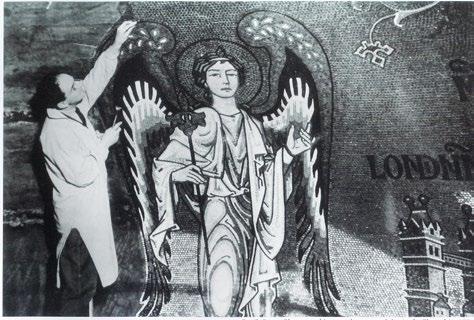
artist was Gilbert Pownall, a Catholic who exhibited regularly at the Royal Academy from 1908. Bourne believed that at last he had found the right man to design the Cathedral mosaics. As Pownall had little or no experience in this medium, Bourne arranged for him to go with Marshall to Ravenna, Rome, Venice and, of course, Palermo and Monreale, to study the masterpieces in mosaic there as Bourne himself had done. During 1926 Pownall set about planning the Cathedral decoration, obtaining a sketch of the main apse and details of Bentley’s 1899 plan for the Lady Chapel mosaics from Archbishop’s House. By the spring of 1927 Pownall had produced a model showing his own designs for the Lady Chapel mosaics which, according to the Westminster Cathedral Chronicle, received much well-deserved praise. Bourne asked him to work rst on the alcove above one of the main confessionals in the south transept near the Lady Chapel, and then on the Chapel itself. He also announced that a workshop and school of mosaics would be set up. In 1930 the workshop was established on the third oor of the
Cathedral tower with Basil Carey-Elwes and omas Josey (both of whom had worked on the mosaics in St Andrew’s Chapel) as the rst mosaicists and boys from Canon Craven’s Crusade of Rescue as apprentices.
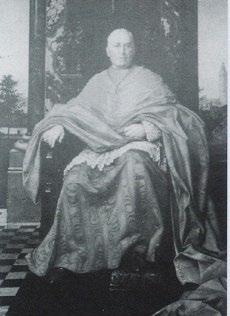
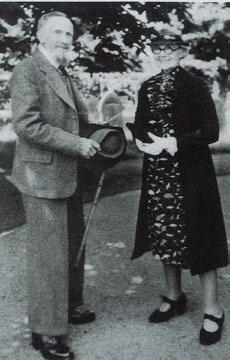
Pownall’s rst designs, showing the penitent St Peter and St Mary Magdalen, were executed in 1930, using the direct method. A start was then made on the Lady Chapel, supervised by Pownall and Lawrence Shattock, the new Cathedral architect-in-charge. By now the team of mosaicists had grown, to three with the arrival of Carlo de Spirt (previously apprenticed to Zanelli) and then to ve with the arrival of Filippo Mariutto and Gian-Battista Maddalena in 1931. Both were originally from Udine near
Venice but they had been working for the German mosaics rm Diespeker on the decoration of Selfridges. e Lady Chapel mosaics took the rst three mosaicists ve years, being competed in June 1935. e apse shows Christ as the Tree of Life with Our Lady as Patroness of London beside the Tower of London, and St Peter as Patron of Westminster beside Westminster Cathedral, together with the archangels Gabriel and Michael and other saints. On the west wall opposite is Our Lady’s Coronation as Queen of Heaven. Running round the chapel is a garland of flowers held by angels and representing a great rosary culminating in Christ above the altar. In amongst the garland and Tree of Life are over 100 animals, insects, fish and birds. Below are scenes such as the declaration of the Immaculate Conception and the appearance of Our Lady to Bernadette at Lourdes. The lower frieze consists of a series of scenes from Our Lady’s life, starting with her parents (Anne and Joachim) with King David, and finishing with St Luke writing his gospel.
While the work was going on in the Lady Chapel, Mariutto and Maddalena were working on the blue sanctuary arch mosaic (tympanum) of Christ in Glory surrounded by the four Evangelists (Matthew, Mark, Luke and John), with the twelve Apostles on either side and a blue background consisting of perhaps a thousand little faces – the host of heaven. A er 18 months’ work this had
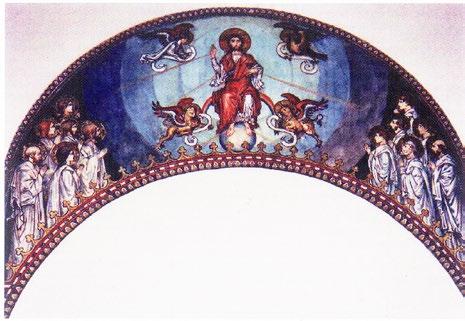
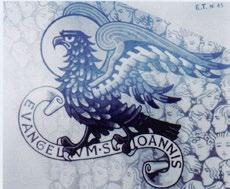

been finished and late in 1933 the two Italians started on the mosaic in St Peter’s Crypt with its scenes of St Peter enthroned, attempting to walk on the water and being presented by Christ with the keys of the Kingdom of Heaven. This was completed by the autumn of 1934 and the pair then turned their attention to the apse mosaic above the Cathedral choir. In July a three foot wide coloured cardboard model of Pownall’s design for the apse had been placed in the Cathedral crypt with a request for comments, one of which, from 16 year-old Aelred Bartlett, resulted in Bourne telling his father that he needed his bottom smacked! The centre of the design consisted of a circle of angels while an outer ring was made up of the apostles. In rectangular panels below were biblical scenes including the Sacrifice of Isaac, The Presentation in the Temple, The Agony in the Garden, the Crucifixion (centre), the Scourging at the Pillar, the Crowning with Thorns, Cain and Abel, Moses in the Bulrushes, the Burning Bush, Pharaoh in the Red Sea, the Tables of the Law and Moses drawing water from the Rock.
Philip Hodges
On State Occasions His Majesty’s Ministers would be present in the nave seated on gilded chairs and a cleric in cassock and soutane would be in attendance on the principals, gently advising them when to stand, sit or kneel since many were not Catholics and could be embarrassed by being exposed prominently in a strange and unknown ritual. I was present when King Alfonso and Queen Ena of Spain attended Mass in State and also when King Albert and Queen Elizabeth of the Belgians did likewise. As crowned and anointed heads, both king and consort were seated on thrones in the sanctuary.
Victory and a er
e Victory March through London in 1919 was an impressive sight headed by the supreme Chiefs of Sta of the Allies riding horse-back. On the following day Marshal Foch, supremo of the Allied Forces attended Mass in State in the Cathedral. We boys were allowed to line the grand staircase in Archbishop’s House as the great man arrived a erwards for lunch with the Cardinal. ere were many state funerals of public men who happened to be Catholics and the military ones were always carried out with the brilliant ceremonial laid down by King’s Regulations which included the deceased’s charger being led with the deceased’s Wellington boots suspended from the saddle in reverse position. One such funeral of military grandeur was that of Sir John Cowans, Quartermaster General of the British Army.
On November 11th 1918, Armistice Day, the cease- re order was given at 11am. Mgr Hall relaxed his normal rigid adherence to the school timetable and took us all in a ‘crocodile’ to the forefront of Buckingham Palace where King George V appeared several times on the balcony. I saw girls seizing the caps from the

heads of senior o cers and exchanging them for their own. Gregory Murray told me that, on his returning from an organ lesson at Trinity College, the bus conductors were not taking fares. ere was a strange euphoria among the crowds milling about the Mall as though all had just emerged from an evil dream of four years’ duration. At the time it would have been inconceivable that in 20 years’ time, another war of even greater ferocity would break out and banish all hope for the peace of mankind.
ere was a mardi-gras atmosphere about and young girls would go around the West End with short bamboo canes at the end of which there was a bunch of feathers. On this rst Armistice Day, the elderly and eminent canon lawyer and theologian, Mgr Moyes, of the Cathedral Chapter had returned from a walk in great indignation: one of these ‘ apper’ girls had dared to tickle his neck with a feather. One can only
speculate on his reactions had he lived into this permissive age when such liberties are normal among the rising generation. Peace celebrations were deferred to the summer of 1919 when a grand reworks display was arranged in Hyde Park. Unfortunately the rework night was marred by a heavy scotch mist. We boys were allowed to ascend the campanile to view the scene from 300 feet up. It was cold and very damp up there and we were surprised to nd that Cardinal Bourne had himself climbed those interminable stairs (there was no li in those days) to watch the pyrotechnics. e observation gallery at the top of the tower is narrow and has many corners. It was embarrassing to nd oneself sharing one of these nooks with this austere and unbending man.
Suddenly the Cathedral’s St Edward’s Tower became a focus of tragedy. At that time the observation gallery had only a parapet three feet high with a simple metal
rail surmounting it; anyone attempting suicide would have no di culty getting over the rail. A er two deaths within a year, the civic authorities stepped in and ordered the Tower to be closed to the public until strong metal cages had been erected to prevent any further deaths. e Tower now has a li and the summit is fool-proof, but the gra ti-mongers have gone to hazardous lengths to carve their names and literary e orts in almost inaccessible places.
We had the normal transient crazes of school life such as stamp-collecting and even the taking of snuff. One of these crazes, the keeping of pet animals, took a hold rapidly. Some boys had purchased rabbits, some guineapigs, some tortoises and others, white mice, all bought from the zoological department of the Army and Navy Stores in Victoria Street. A very studious boy, clever but a bit of a book-worm, had two guinea pigs. I remember how deeply I respected his knowledge when he told me that ‘when they climb over one another it’s a sign they’re about to become parents’ – no other details were vouchsafed, however. At age 12 I was totally green and still wet behind the ears.
For myself I chose harmless grass snakes about 9 inches long. I had a shallow wooden box lled with straw and leaves and covered by a piece of glass so that I could see my captives. ere were long spells when I could not visit my snakes since they were on the far side of the playground; getting anxious about their lack of air, I bored holes in the side of the box for ventilation. Within one day my snakes had gone: I had not realised how easily they could squeeze through the holes. e next day the Westminster Gazette carried the vivid story and photograph of the caretaker of one of the Morpeth Terrace ats who, it alleged, had risked his life in beating to death a poisonous adder he had found under the mat of his entrance lobby. e next day the paper carried another story of a further brave encounter, praising the caretaker and adding: ‘some madman in the neighbourhood is liberating snakes and should be apprehended as soon as possible’. Mgr Arthur Jackman, the cardinal’s secretary, cut these reports from the paper and posted them on the school notice board. All the pets had to be kept outside and the makeshi huts
were inadequate. Ignorance and a spell of cold weather took a heavy toll and one of the deceased rabbits provided Fr Collings with a subject for dissection which he carried out like a medical student for our admiration.
Morpeth Terrace was popular for itinerant musical beggars, two of whom attended regularly and precisely at the same time each week. e female singer would make a passable attempt at Gounod’s Ave Maria and would hold up a black silk domino to her face as if to conceal her identity and giving the impression of having fallen from stardom. e man would play three mournful melodies on a wheezy hurdygurdy and they would both move down the centre of the Terrace for there was little tra c. is visit sometimes coincided with the maths lesson and I always associated these doleful dirges with trying to extract the square root or some other cerebral ordeal.
Timetable
e daily curriculum of the school remained unchanged during my time and was constant throughout the seasons. We would be roused at 6.30am by the rector or his assistant walking round the dormitory loudly clapping his hands. We would go to the washplace, a narrow passage lined on each side by small circular wash basins set in a continuous slab of marble. Each basin had only one tap of the press-down type supplying only the cold hard water of the London region.
Air locks in the pipes made the characteristic noise when the taps operated. The soap was ‘Brown Windsor’ giving off the pungent odour of carbolic. Each boy had an eye-level locker with mirror doors in which he had his toilet requisites. Mine had the stale odour of a wet hairbrush because I used to plaster my black hair down with water like Burlington Bertie.
Our individual towels were hung over a central radiator. As there were only 20 bowls between 32 boys there was competition to get first place. At 6.50am we would assemble on the lower landing and the rector would call the roll, to which we would answer Adsum (i.e.,Present). Six boys would be detailed to serve several 7 o’clock masses in the side-chapels whilst the remainder would go to the crypt for Mass.
This crypt chapel is a low-vaulted area under the choir apse and lined round the walls with metal cupboards with ornate brass doors. These were the reliquaries containing the tiny bits of bone from the bodies of canonised saints, each in an envelope sealed by a bishop and containing a certificate of authenticity. Periodically an auxiliary bishop would perform the private ceremony of the consecration of altar stones in the crypt during which he would seal a relic of a saint in each stone. These stones would then be distributed for insertion into the altar slabs of churches in the Westminster Province.
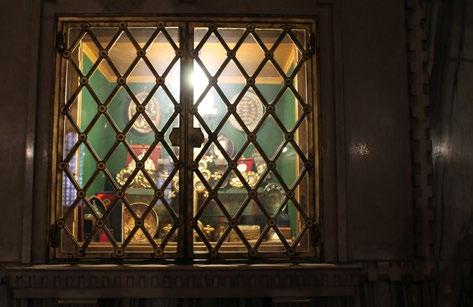
Name
Although the Feast of Our Lady of Lourdes was displaced by a Sunday, the Cathedral was packed on the preceding afternoon for a Mass of the feast with anointing of the sick. Bishop Paul is seen here administering the Sacrament.
Bishops and Diocesan Clergy renew their vows at the Chrism Mass in Holy Week; for Religious, however, the time for Renewal comes in association with Candlemas and so members of communities from across the diocese came together a day later on 3 February for Mass with the Cardinal, shown at the post-Mass reception in Cathedral Hall.

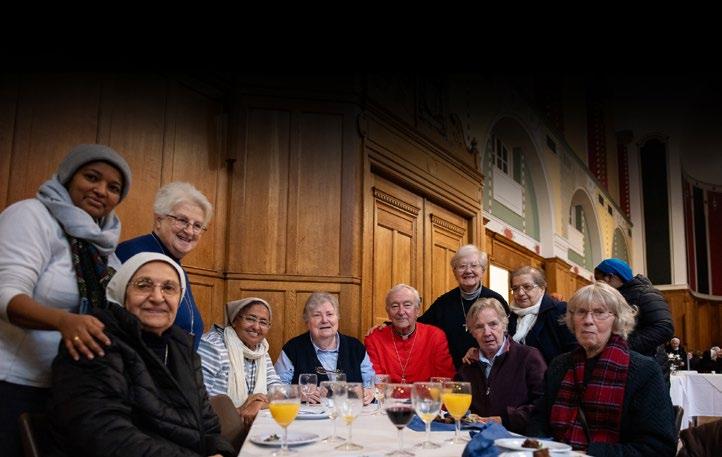
Oremus congratulations go to the boy who kicked the ball so hard that it lodged firmly between the pipes but avoided breaking Fr Brian’s office window!

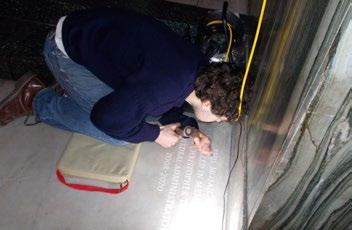
Stone carver George S Edwards recently completed Canon Christopher’s memorial with an inscription on the floor beneath the mosaic of St Augustine of Hippo.
You can read on page 26 about how the Friends of the Cathedral have taken on helping with the restoration of the wooden floor. The images below show sanding taking place, the stripped and cleaned wood blocks and then the restored result.



Paul Tobin
To mark the 15th centenary of the translation of the body of St Patrick, Cardinal Francis Bourne, Archbishop of Westminster 1903-1935, assisted at Solemn Mass at St Patrick’s Church, Soho, whilst at Westminster Cathedral the Holy See had given permission for the 10.30am High Mass to be that of St Patrick instead of the Lenten Feria and decreed that in future on March 17th it would be the Mass of the Saint that was to be celebrated.
It is not known when the custom of singing the hymn Hail glorious St Patrick at the conclusion of High Mass started, but it was certainly being sung in the 1960s.
e High Mass was attended by Lt Col e Viscount Gough and other ranks of the 1st Battalion Irish Guards. Judging by the numbers of red tunicked Guardsmen who are seen marching past the front of the Cathedral, one can only imagine how impressive the sight must have been when they were lling the seats in the nave.
Sources: Westminster Cathedral Chronicle April 1932 Image: From the Archives, Vol 2, A Universe Special Publication
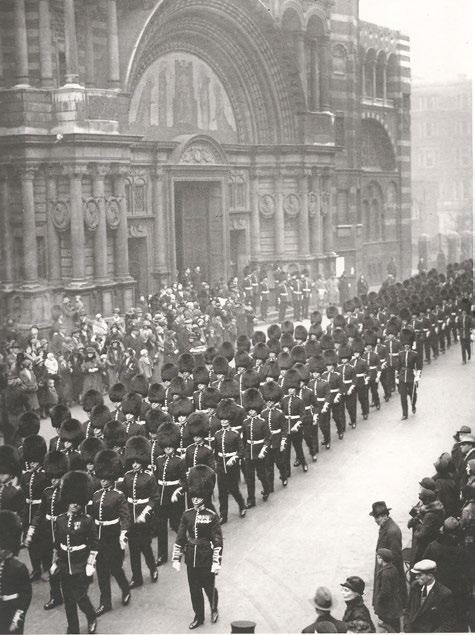
Patrick’s Day Celebrations, 17th March 1932
Name:
Address:
is available for collection from the Cathedral,

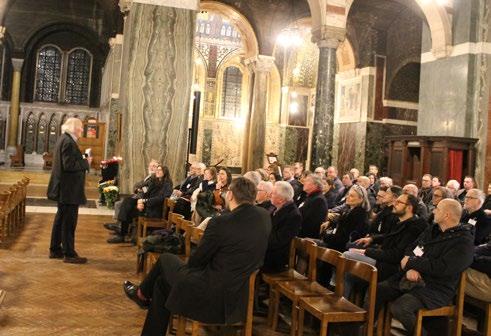
e search is underway for an artist to design a mosaic scheme for the Baptistry, which is the Cathedral’s penultimate undecorated chapel. is is why, on the evening of Friday 26 January, 22 artists were invited to the Cathedral to familiarise themselves with the space and to learn at rst-hand about the history of the Cathedral and its interior design.
Not all churches have baptistries, many having a simple font near the entrance or a portable font which can be taken out and used as and when the need arises. For instance, in the Cathedral, even though we do have the Baptistry, for pastoral reasons many baptisms do take place in the Lady Chapel and a portable font is set up there for that. When US President John F Kennedy visited for the baptism of his niece Anna Christina Radziwill, a portable font was set up in the Crypt for that occasion – no doubt to retain the privacy of an intimate family event from the prying eyes of those wishing to catch a glimpse of such a well-known public gure.
So, what is a baptistry and why does the Cathedral have one? A baptistry is a designated area used for initiating new members into the Church. Needless to say, this means that the decorative centrepiece of the baptistry is the font and Westminster Cathedral is no exception. Our Baptistry has a substantial marble font made in Rome in 1901 on the instructions of Cardinal Vaughan, who had received the necessary funds from the Dowager Lady Loder. It was designed by Cathedral architect John Francis Bentley himself.
e Chapel is a square cross-vaulted space adjoining the Chapel of St Gregory and St Augustine, the two spaces being linked by an arched gateway. e arch is decorated with mosaics depicting the four rivers of Paradise, thus emphasising the link between baptism and conversion. Further decorative items include a large copy of orvaldsen’s statue of St John the Baptist in Copenhagen Cathedral presented to the Cathedral by the Marquess of Bute in 1900 and a small nely carved wooden statue of St Christopher, outside the Chapel
gates, presented by Catholic author Hilaire Belloc; an inscription on a bronze plate at the foot of the statue narrates the story of his giving it a er seeing his son set o to ght in Flanders during the First World War. However, the whitewashed upper walls and vault are in stark contrast to the Cathedral’s other Chapels and provide a blank canvas for future mosaic work.
At the event itself, a er a welcome from the Cathedral Dean, and an introductory theological speech from the Cardinal, Peter Howell, a member of the Cathedral’s Art and Architecture Committee since 1974, who has written a book on John Francis Bentley, and has an in-depth knowledge of the Cathedral, spoke at some length about the artistic history of the building. His talk was followed by an opportunity for the artists to examine the Baptistry and the entire Cathedral at leisure, thus giving them time to assess the scale and size of the project and how it might t into the wider decorative legacy of mosaic.
e evening culminated with a reception in Clergy House’s library, to enable the artists to mingle and discuss the project. Whilst assembled there, Suzi Pendlebury, Cathedral architect addressed the gathering, inviting the artists to put forward their design proposals. With God’s blessing, in due time we hope to have this Chapel completed with mosaic decoration worthy of this sacramentally most important part of the Cathedral.
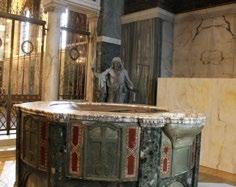
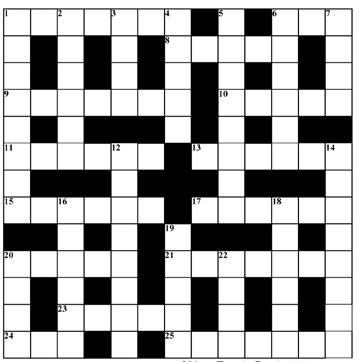
Clues Across
1 & 6: Name of marshland area of Westminster that existed on site of Cathedral (7,3)
6 See 1 Across
8 Charge imposed on little island? (5)
9 Member of choir (7)
10 Cherub in Islington on the Monopoly board! (5)
11 Having correct musical sound and understanding! (2,4)
13 See 3 Down
15 Patron Saint of England (6)
17 Colloquially a mad person, and a classic Hitchcock lm (6)
20 Vote for the ‘chosen’ of God? (5)
21 ‘Rich as -------’,a Roman General, as the saying goes (7)
23 Young sh that, when grown, used to be a popular dish with Londoners (5)
24 Large barrel, especially of wine or beer (3)
25 St --------Tower, name of the Cathedral campanile (7)
Clues Down
1 Given by the priest at the end of Mass (8)
2 Shell sh or mine (6)
3 & 13 Across: Province of Canada with world’s highest tides (4,6)
4 Brother of Moses, led the Israelites out of Egypt (5)
5 ey have been crowned at Westminster Abbey for centuries (7)
6 ‘ e ------ into Egypt’, event, much painted, of Holy Family’s escape from threat of Herod (6)
7 Irish boy’s name and ‘ e First’ carol (4)
12 Opposite of a positive attitude (8)
14 St -------- de Gonzaga, died only 23 caring for plague victims (8)
16 See 20 Down
18 One of the ree Wise Men (6)
19 Notation and words for twenty musicians? (5)
20 & 16: Where Cain was banished and novel by Steinbeck (4,2,4)
22 Make solemn declaration (4)
Hilaire Belloc
ey warned Our Lady for the Child at was Our Blessed Lord, And She took Him into the desert wild, Over the camel's ford.
And a long song She sang to Him
And a short story told:
And she wrapped Him in a woollen cloak
To keep Him from the cold.
But when Our Lord was grown a man e rich they dragged Him down, And they cruci ed Him in Golgotha, Out and beyond the town. ey cruci ed Him on Calvary, Upon an April day; And because He had been Her little Son She followed Him all the way. Our Lady stood beside the Cross, A little space apart,
And when She heard Our Lord cry out A sword went through her heart. ey laid Our Lord in a marble tomb, Dead, in a winding sheet.
But Our Lady stands above the world With the white moon at her feet.
Christina Rossetti
I have no wit, no words, no tears; My heart within me like a stone Is numb'd too much for hopes or fears; Look right, look le , I dwell alone; I li mine eyes, but dimm'd with grief No everlasting hills I see; My life is in the falling leaf: O Jesus, quicken me.
My life is like a faded leaf, My harvest dwindled to a husk: Truly my life is void and brief And tedious in the barren dusk; My life is like a frozen thing, No bud nor greenness can I see: Yet rise it shall—the sap of Spring; O Jesus, rise in me.
My life is like a broken bowl, A broken bowl that cannot hold One drop of water for my soul Or cordial in the searching cold; Cast in the re the perish'd thing; Melt and remould it, till it be A royal cup for Him, my King: O Jesus, drink of me.
To submit a poem whether by yourself or another for consideration, please contact the Editor – details on page 3.
e work on the marble screen at the west end of the Cathedral, which has been delayed owing to an accident at the works of Messrs. Farmer and Brindley, has now been resumed, and the screen (of the Grand Organ) will shortly be completed. e six marble columns have been erected on the gallery, and all the other marble work is ready for delivery. e xing of the capitals and the upper part of the screen will not take much time, as it is all straightforward work, and unless anything quite unforeseen occurs the sca olding which has for so many months hidden the west end of the building will disappear, and this further addition to the beauty of our great church will be seen.
from the March 1924 Westminster Cathedral Chronicle
We have each to share in the mission entrusted to the church by Christ. e means of ful lling this duty must vary within the spheres of our ordinary daily activity. But because the outlet to our apostolic endeavours may be restricted – professionally, locally, parochially, even domestically – we must not lose sight of the universality of the Church’s mission. Catholic means universal. Any narrowness of outlook or of sympathy is utterly alien to a truly Catholic mind. Anything that is good or true in humanity comes from Christ. But in the Church alone can mankind nd ful lment.
For this reason Catholics must always take an active interest in current a airs and be alive to contemporary needs and preoccupations. ey cannot dissociate themselves from the world to which they must carry the teachings of Christ. ey must feel deeply with all that is good and true in the aspirations of their fellow creatures. In the spirit of their Master, Who came ‘not to be served but to serve,’ they must enter even more fully than they do at present into the whole life of the community, accepting the duties and responsibilities of public life and co-operating to the full in the eld of voluntary endeavour. To all this must Catholics give themselves in a spirit of sel ess generosity, with no other motive than the glory of God and the service of men. ‘Your light must shine so brightly before men that they can see your good works, and glorify your Father Who is in heaven.’
Whatever our role in life, wherever we are and whatever we do, we are witnesses to Christ. This is the inescapable consequence of our baptism which imprints upon our souls a sacramental character, marking us forever as member of Christ’s Church. This is the privilege of our faith and it bears with it an immense responsibility. We are either true witnesses or false witnesses. A Catholic whose life is a contradiction of his faith is a cause of grave scandal, leading others away from the truth. On the other hand the Catholic who lives a fully Christian life gives witness to the truth. Indeed his personal sanctity leads others to Christ. We know from experience that the example given by good Catholics is at the root of nearly every conversion to the true Faith. The precepts of the Church and her moral teaching are to be regarded, not as a burden, but as a sacred responsibility. In following these precepts we have the means of showing to others the love and wisdom of our Lord. To ignore or even to minimise any single obligation of the Christian life is a betrayal of the truth entrusted to us by Christ. It is a betrayal of Christ Himself and rightly earns the contempt of non-Catholics. People will be attracted to the Church, not by Christianity watered down and on easy terms, but by seeing the full Christian ideal lived with complete sincerity. Our essential witness to Christ is not one of argument or controversy, even though at times these may have their place. Our witness to Christ is our personal sanctity.
During Lent let us strengthen our union with Christ by frequentation of the sacraments. By confession and by the reception of Holy Communion we win the grace to live according to the teaching of our Lord Jesus Christ and to carry out the mission which He has entrusted to us. Our mission field lies about us, in our homes and in our public life. Wherever we are we must reflect His truth to a world in which He abides for all time but which does not know Him as we do. ‘As God’s favoured children, you must be like Him. Order your lives in charity which Christ showed to us, when He gave Himself up on our behalf, a sacrifice breathing out fragrance as He offered it to God.’
Given at Westminster on the feast of Our Lady of Lourdes and appointed to be read in all the churches and chapels of our diocese on Quinquagesima Sunday in the year of our Lord nineteen hundred and fifty-four.
from the March 1954 Westminster Cathedral Chronicle
Tales of the English Martyrs
St Margaret Clitherow, martyred Good Friday, 25 March 1586: At 8am the Sheri s called, and with them she walked barefoot, going along through the crowd to the Tolbooth. ere, turning from the Protestant ministers, she knelt and prayed by herself. Forced to undress, she laid herself on the ground, clothed only in the linen habit, her face covered with a handkerchief, her hands outstretched and bound as if on a cross. e weighted door was placed on her; at the rst crushing pain she cried, ‘Jesu ,Mercy’ and a er a quarter of an hour passed to her God.
e Holy Father’s Prayer Intention: For New Martyrs:
Let us pray that those who risk their lives for the Gospel in various parts of the world might imbue the Church with their courage and missionary drive.
Friday 1 March Ps Week 2
ST DAVID, Bishop, Friday abstinence Patron of Wales
* World Day of Prayer
6.15pm Stations of the Cross
Saturday 2 March
Lent Feria
4pm Low Mass (Blessed Sacrament Chapel)
Sunday 3 March Ps Week 3
3rd SUNDAY OF LENT
12pm Solemn Mass (Full choir)
Palestrina – Missa Aspice Domine
Tallis – In ieiunio et etu
4pm Solemn Vespers and Benediction
Victoria – Magni cat octavi toni
Allegri – Miserere mei Deus
4.30pm Mass for the Deaf Service (Cathedral Hall)
Monday 4 March
Lent Feria (St Casimir)
Tuesday 5 March
Lent Feria
5.30pm Chapter Mass
Wednesday 6 March
Lent Feria
1.15pm Lunchtime Concert
Thursday 7 March
Lent Feria
(Ss Perpetua and Felicity, Martyrs)
Friday 8 March Friday abstinence
Lent Feria
(St John of God, Religious)
6.15pm Stations of the Cross
Saturday 9 March
Lent Feria (St Frances of Rome, Religious)
e Cathedral is open from 7.30am and closes in time for 7pm.

Monday to Friday: Morning Prayer 7.35am, Mass 8am, Mass (Latin, unless there is a Funeral) 10.30am, Confessions 11.30-12.30pm, Mass 12.30pm *, Exposition of the Blessed Sacrament 1.15-4.30pm, Benediction 4.30pm, Confessions 4.30-5.30pm, Sung Vespers 5pm (Latin, Choir, except Tuesday, English, Cantor), Solemn Mass 5.30pm (Choir, Tuesday: Boys’ voices, Wednesday: Men’s voices).
Saturday: Morning Prayer 7.35am, Mass 8am, Mass 10.30am (Latin, Choir), Confessions 11.30-12.30pm, Mass 12.30pm *, Confessions 5-6pm, Sung Vespers 5.30pm (English, Cantor), Sung Mass 6pm.
Sunday: Mass 8am, Sung Morning Prayer 9.30am, Sung Mass 10am, Confessions 10-12.30pm; Solemn Mass (Choir) 12noon *, Solemn Vespers and Benediction (Choir) 4pm, Confessions 5-6.45pm, Sung Mass 5.30pm, Mass 7pm.
For full opening and closure times of the Cathedral and for confession and service times, please consult the Cathedral diary on the website.
* Live streamed via the Cathedral website

6pm Visiting Choir: Marriage Preparation Course Couples attend Mass
Sunday 10 March Ps Week 4
4th SUNDAY OF LENT (Laetare)
12pm Solemn Mass (Full choir)
Mozart – Missa brevis in F major (K.192)
Victoria – Ave Regina cælorum a 5
Organ: J.S. Bach – Pièce d’orgue (BWV 572)
4pm Solemn Vespers and Benediction
Lassus – Magni cat primi toni Brahms – Wie lieblich sind deine Wohnungen
Organ: Franck – Cantabile
Monday 11 March
Lent Feria
Tuesday 12 March
Lent Feria
Wednesday 13 March
Lent Feria
1.15pm Lunchtime Concert
Thursday 14 March
Lent Feria
7.35 Morning Prayer, 8, 10.30am Mass in the Crypt
12.30pm Mass, 5pm Evening Prayer, 5.30pm Mass in Cathedral Hall
7.30pm Bach St John Passion (ticketed)
Friday 15 March Friday abstinence
Lent Feria
6.15pm Stations of the Cross
Saturday 16 March
Lent Feria
Sunday 17 March Ps Week 1
5th SUNDAY OF LENT
12pm Solemn Mass (Full choir)
Byrd – Mass for ve voices
Palestrina – Tribulationes civitatum
Palestrina – Peccavimus cum patribus nostris 4pm Solemn Vespers and Benediction
Palestrina – Magni cat quarti toni Poulenc – Timor et Tremor
Monday 18 March
Lent Feria
5.30pm Vigil Mass of St Joseph
Tuesday 19 March
ST JOSEPH, Spouse of the Blessed Virgin Mary, Patron of the diocese
8, 10.30am Mass in St Joseph’s Chapel
5pm Second Vespers
5.30pm Solemn Mass; attended by the Society of St Augustine (Full choir de Padilla – Missa Ego os campi
Mawby – Iustus ut palma
Ett – Te Ioseph celebrant
Organ: Lübeck – Præludium in E (LübWV 7)
Wednesday 20 March
Lent Feria
1.15pm Lunchtime Concert
Thursday 21 March
Lent Feria
2pm SVP School Passion Play
Friday 22 March Friday abstinence
Lent Feria
6.30pm Stations of the Cross
Saturday 23 March
Lent Feria
(St Turibius of Mogrovejo, Bishop)
6pm Victoria Choir sings at Mass
Sunday 24 March Ps Week 2
PALM SUNDAY OF THE PASSION OF THE LORD
11.30am Procession and Solemn Mass (Full choir)
Byrd – Mass for four voices
Byrd – Ne irascaris
Byrd – Civitas sancti tui
4pm Solemn Vespers and Benediction
Victoria – Magni cat octavi toni Lassus – Improperium exspectavit
4pm Solemn Vespers and Benediction
Monday 25 March
MONDAY OF HOLY WEEK
Tuesday 26 March
TUESDAY OF HOLY WEEK
12pm Solemn Ponti cal Mass of Chrism (Full choir)
Haydn – Missa brevis Sancti Ioannis de Deo Elgar – e Spirit of the Lord Mawby – Ave verum corpus
Organ: J.S. Bach – Prelude in E at (BWV 552)
Wednesday 27 March
WEDNESDAY OF HOLY WEEK
4pm e O ce of Tenebræ, broadcast live on BBC Radio 3 (Full choir)
5.10pm Evening Prayer (said)
5.30pm Solemn Mass
Thursday 28 March
MAUNDY THURSDAY
6pm Solemn Evening Mass of the Lord’s Supper (Full choir)
Vaughan Williams – Mass in G minor Duru é – Ubi caritas
Friday 29 March Fast and abstinence
GOOD FRIDAY
10am O ce of Readings (Full choir)
Victoria – Tenebræ Responsories
Anerio – Christus factus est
3pm Solemn Liturgy of the Passion (Full choir)
Bruckner – Christus factus est Victoria – Passion according to John Victoria - Improperia
King John IV of Portugal – Crux delis
Sanders – e Reproaches
Lotti – Cruci xus a 8
6.15pm Stations of the Cross
Saturday 30 March Fast as desired
HOLY SATURDAY
10am O ce of Readings (Men’s voices)
Victoria – Tenebræ Responsories
Anerio – Christus factus est
8.30pm e Easter Vigil in the Holy Night (Full choir)
Lassus – Iubilate Deo omnis terra
Reid – Exodus canticle
Palestrina – Sicut cervus
Vierne – Messe solennelle in C sharp minor
Palestrina – Dextera Domini
L’Héritier – Surrexit pastor bonus
Organ: Vierne – Final (Symphonie VI)
Sunday 31 March
EASTER SUNDAY OF THE RESURRECTION OF THE LORD
12 noon Solemn Ponti cal Mass (Full choir)
Widor – Messe
Bassano – Dic nobis Maria
Organ: Dupré – Prelude & Fugue in B major
4pm Solemn Vespers and Benediction (Men’s voices)
Bevan – Magni cat primi toni
Palestrina – Surrexit pastor bonus a 8
Organ: Langlais – Incantation pour un jour saint
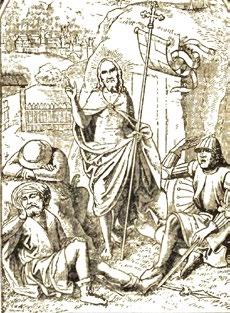
Key to the Diary: Saints’ days and holy days written in BOLD CAPITAL LETTERS denote Sundays and Solemnities, CAPITAL LETTERS denote Feasts, and those not in capitals denote Memorials, whether optional or otherwise. Memorials in brackets are not celebrated liturgically.
Catholic Grandparents’ Association Hinsley Room, Second Sundays 12-3.30pm
Charismatic Prayer Group
Cathedral Hall, Fridays 6.30-9pm
Divine Mercy Prayer Group
St Patrick’s Chapel, Sundays 1.30-2.30pm
Filipino Club
Hinsley Room, First Sundays 1-5pm
Guild of the Blessed Sacrament
Blessed Sacrament Chapel, Mondays 6.15pm
Guild of St Anthony Lady Chapel, Tuesdays 6.15pm
Interfaith Group Hinsley Room, ird Wednesdays 2-3.30pm
Legion of Mary Hinsley Room, Monday 1.30-3.30pm
Nigerian Catholic Association Hinsley Room, Fourth Sundays – 1.30-2.30pm
Oblates of Westminster Cathedral Hinsley Room, Fourth Sundays 2.30-4pm
Padre Pio Prayer Group
Sacred Heart Church, First ursdays 1.30-3.30pm
RCIA Group
Vaughan House, Tuesday 7-8.30pm
Rosary Group
Lady Chapel, Saturday 10-10.25am
Walsingham Prayer Group
St George’s Chapel, First Tuesdays 2.30-4pm
Yoruba Association
Hinsley Room, ird Sundays 1.30-3pm
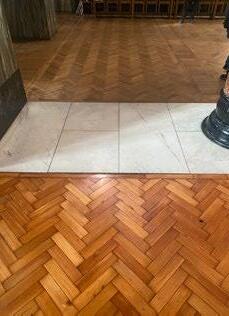
With Lent beginning early, and a plethora of activity over the past few months across the Cathedral, it feels like we have been progressing seamlessly and quickly between seasons and feasts – Advent, Christmas and its Octave, Epiphany, Candlemas as I write these words, and Ash Wednesday just past. This is far from a complaint – the ebb and flow of the liturgical year picks us up and carries us along.
I have to say, it feels rather the same with our fundraising work at the moment. In the last six months, we have seen a mosaic of St Augustine blessed and formally ‘welcomed’ into its new home, our £300,000 sanctuary lighting pledge come to fruition, and, in late January, the mosaic@s dedication to Canon Tuckwell chiselled into the floor below. We have progressed from one project to the next, thanks in no small part to the generosity of our members and supporters, and now our attention turns to another phase in our mission.
We often look up – to the altar, main sanctuary, the sacred ministers standing below the baldacchino, dominating rood, and the vaults and domes of the Cathedral whether with mosaics or or awaiting them. But how often do we look down to the ground beneath us, and the floor on which we walk? As with every last thing in the Cathedral, there is a history and story to this most functional of features.
Speaking to our architect Suzi Pendlebury, I discovered that designing architect John Francis Bentley originally designed a marble floor, but for financial and also practical reasons, including marble making English churches even colder than they tend to be already, a pitch pine timber floor, intersected with marble at regular intervals was installed instead. As far as she knows, the flooring in the main nave is original, but has not been refurbished for quite some time. Moreover, the Covid pandemic halted the regular routine of polishing and maintenance.
The wear and tear of recent years, alongside damage over the previous years, has made refurbishment as well as maintenance a priority to conserve over 1,800m2 of original timber block floor. A first pot of money was provided by a donor for the Blessed Sacrament and Lady Chapel areas, and the impact is both plainly visible, and greatly valued in verbal feedback. Restoring the floor throughout to good condition has now begun, and The Friends are keen to see this continue.
So, we are picking up the gauntlet of fundraising for the refurbishment and restoration of all the flooring in the Cathedral. To achieve this, circa £125,000 project for the benefit of the entire Cathedral, we will be running several campaigns, including a twoweek Big Give to coincide with Easter, running from noon on Monday

25 March to noon on Monday 8 April. With a matched pot of £25,000, we are hoping to raise a total of £50,000 – which will give substantial headway allowing work to continue immediately. Further information and donation links will be circulated in due course at www.TinyURL.com/CathedralFriends and all the usual Cathedral and Friends communication channels.
Bringing the look and the state of the flooring up to scratch and providing a sure base for future maintenance, this new project will serve the Cathedral for years to come.
The Friends run Big Give campaigns at least once a year. The premise is that thanks to a ‘matched pot’, your donations are doubled at no extra cost to you. So, if you donate £10, it is doubled to £20, and if you are eligible for Gift Aid, becomes £22.50. These campaigns are therefore a doubly beneficial and effective opportunity to contribute to the life of the Cathedral.
We are busy here at The Friends not just planning fundraising campaigns but a varied schedule of events, too. At the present time we are pleased to give notice of two quizzes to take place in the coming months: Thursday 25 April and Thursday 6 June, both from 6:30pm. Ticket reservations (at £20pp including fish and chips) can be made now by emailing friends@rcdow.org.uk – an Eventbrite ticket link will be publicised in due course, alongside our other plans for summer and further on through the year.
Year 6
Easter is a time of great celebration as it marks the Resurrection of Jesus on that day over two thousand years ago. Before Easter comes the season of Lent, which begins on Ash Wednesday, (this year it falls on 14th February which is also St Valentine’s Day!) where last year's blessed palms are incinerated to ashes, which are then used in Mass, where we have a cross of those ashes placed on our foreheads. Ash Wednesday starts the 40 days of Lent.
Lent is a time of prayer, fasting, and almsgiving as we remember Jesus fasting in the desert for 40 days and 40 nights while being tempted by Satan. During Lent, we do many things as a school community. We make our Lenten promises by writing them down, and try our best to follow them throughout all of Lent. We gather together for a special assembly where we place all of our written promises into special envelopes, they are then placed into together in our School Hall during Lent.
We also have our Penitential Service where Fr John, Fr Vincent, and Fr Chinedu come into our school and they help us receive the sacrament of reconciliation as we tell them our sins and they grant us absolution. During the Penitential Service, the Priests all tell us individually which prayer to say, this is called our penance. We then go into our School Chapel to say our penance.
We also support the Catholic Children’s Society (CCS), who help children who need support with money, food, and other essential items such as beds, clothing, and other necessary items which those children need to be safe, happy and warm. We donate to the CCS every year in Lent and each person in the school gets a Lenten box to put the donations in and we give all the money to the CCS.
One of the main things that happens in the school in Lent is the Passion Play. Every year, Year 5 acts out the story of Easter from start to end. We have many props and costumes that we use to make the re-enactment of Jesus’ last days on Earth as real as possible. We have readers who explain everything that is going on perfectly. Last year, I was in the Passion Play and I played the part of Judas. The Passion Play is planned out from the betrayal of Jesus and the sorrow that is felt to the joy of the Resurrection, so it almost seems real.
This year The Passion Play will be performed by Year 5 in Westminster Cathedral in the week before Holy Week on Thursday 21stMarch at 2pm. Come along and see for yourself what we do at St Vincent de Paul School to recognise and reflect on this important time.

